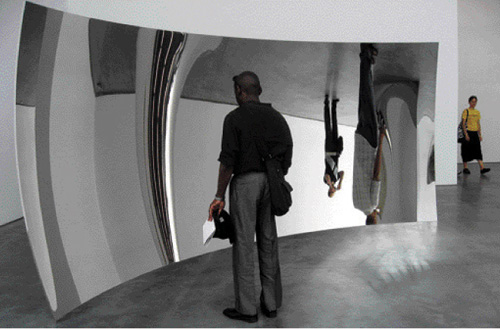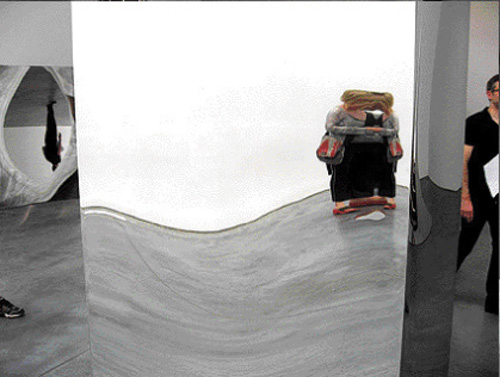
□ 刊发于
《城市环境设计》
2009年第01期
□ 阅读次数:6894
□ 现有评论:0
□ 查看/发表评论 |
|
|
安尼诗卡普尔:感觉先于认知
本刊|文、图/王珏
|
ANISH KAPOOR: Perception before Cognition
文、图/王珏
观看并不仅仅是看。艺术教会人们如何去看。
——艾德·莱因哈特(1946)


2008年5月12日,当我走进坐落于西21街530号的新格迪斯通美术馆,这个有着顶部亮光的空间是一个立方体,开幕展览时,由安尼诗卡普尔创作的四个精美的不锈钢几何体映射着周围变形的物体出现在我的面前。伴随着周围的物体,有着完美比例的纯白体块空间被反射在了精美的不锈钢几何体上。它是不锈钢熔块融化、消融、混合流程的瞬间体现。我在最高的一块熔钢前停住了脚步。“无题(门),2008,不锈钢”。我拿出我的手机拍照想留住这一凝固的瞬间。
现在当我看到这些照片,我觉得照片中处于静止的厚重形状并没有捕捉到展览上那完美的瞬间。没有波纹,感受不到几何体的体量。流动性被冻结了。我想到由于杂志文章或者展览目录照片被狭隘的曼哈顿的“黏性”。这种抑制在这里被惊奇的反映。我认为在静止的照片中,建筑,通过空间中的体块所体现出来的黏性,不稳定性和易变性全部都消失了。在瞬间我们捕捉到一张物体处在延展状态的照片。但在5月12日那个时刻一切重要的东西,最直接的感受,先于认知的东西在定格的照片中都丢失了。这是卡普尔的作品在空间中体现的短暂和脆弱。这种短暂和脆弱的特性以及其令人惊奇和不可预见的品质和建筑是一样的。
我第一次遇见安尼诗卡普尔是在1997年的赫尔辛基。杜拉,当时在建的Kiasma博物馆的馆长,邀请他在博物馆的外墙高处上创作一件作品(这个项目最后没有实现)。我对于他选择了卡普尔感到非常的兴奋,因为我研究了他的早期作品并从中体会到了他对于感觉的灵魂揭露。Kiasma博物馆,拥有25个美术馆并且每个美术馆都采用不同的自然采光方式,这种构想源自身体在空间里运动的位置。对于一系列现象的空间的体验,是与在同一年开幕的Bilbao博物馆以图像为目标的主题大相径庭的。现象与图像这两个相差甚远的概念在当今的建筑中扮演着重要的作用。卡普尔的装置是对现象和图像的含义综合之后的重新定义。
在进行建筑或者艺术创作的时候,对于物质世界的微妙感觉是非常重要的。就像我们能够通过对乐器的微妙调整就能够创作出旋律一样,我们同样具有协调视觉和空间感受让它们达到和谐的能力。无论是在音乐还是在建筑和视觉艺术中,这种感知力是相类似的。在过去的10年里,人的体量,与之相关比例,城市的体量,这些无论是在建筑还是在艺术中都是非常重要的东西都被忽略了。21世纪人们再次呼唤在建筑和艺术中,对于宏观和微观尺度的概念。卡普尔对于人体作为一种体验的载体的重申以及他坚定不移在天性模糊的知觉世界重建根基的目标,让我们对于比例和尺度重新发问。他向我们展示了在微观尺度对于体验的阐明是通过怎样一种扼要的方式,以及宏观尺度是怎样体现现象的尺寸的。
从2001年安尼诗卡普尔在诺丁汉和2007年在洛克菲勒中心的天空之镜或者2004年在芝加哥的云之门,他的作品尺度和空间上的重视日渐增长。卡普尔特别专注于建筑的体量。在我们身边无处不在的扩张和建设中,新的空间形式有可能就此形成。如同卡普尔向我们展现的那样,我们可以找到主观和客观的引线,看到我们的行为能力,这是对于微观世界和宏观世界的探索,是对内在和外在感受的探索以及对心理空间和公共空间的探索。
如同梅洛庞蒂所说的身体的两面性,我们的身体既是理性的又是感性的,这两个截然不同的概念可以分辨出“自知”和“自觉”。 如果在梅洛庞帝的讨论中找到一个平衡点,我们可以发现空间一方面避免了古老的僵局同时又逃离了新的陈词滥调。我们试图在开始显露未曾预料到的对象和主题顺序间的关系上探寻空间现象。现象学可以作为研究的方法之一。它取代了经典的对称,取代了解构,在现象间互相探寻。每次稍微偏向一方同时尊重另一方。在时代导向上(结构主义代替了后现代主义,超现代主义代替了解构主义),现象学可以引领我们的思考,将本质还原为存在。
要实现这些需要我们参加到每天笼罩在神经官能症下的世界的活动,走入充满神秘且急需解密的世界。 精神的平衡,简单或复杂的几何体,光线的质量,表面的形象,开敞的空间,每一样都具有各自的效用。空间如果要成为灵魂的港湾、光线、颜色、肌理以及空间关系都是不可或缺的因素。空间,作为灵魂的载体,可以同时具有明澈性、映像的模糊性,创造性和热情。它可以改变我们对于时间和季节的体验,让我们从对物体的感知中分辨出时间和空间,为我们提供一个“先理论”区域。这种感觉是先于逻辑的。它要求不通过想法的演绎来创造空间,而是空间根据自身的功能形成自己独有的形式。
在我们大约10年前的第一次介绍以后,安尼诗卡普尔将自己的创作拓展到心理学领域。他的作品向我们展示了不管建筑的体量如何,以何种形式存在以及他以何种方式介入,人们对于建筑的反应不一。卡普尔的装置不仅仅是针对知识分子,而且也面向年仅5岁只是伸手触摸墙壁的孩童;或者如同卡普尔声称的那样:这是与符号相关的东西,是孤立于功能需求的某种形式,起到的是纯抽象的作用。卡普尔不仅仅是创造了一个三维的空间,而且还包括环绕在三维空间周围的与其息息相关的空间。从心理学意义上,卡普尔的作品中,空间在被认知以前已经被感知了。梅洛庞蒂将这种现象描述为事实之间的存在,它提供了一种可能性,可以将所有的事情联系在一起。除了对于物质空间,他们的体验并不仅仅是对于事件发生地,物体和活动,还包括一些难以名状的东西,如持续展开的重叠空间,材质和细节。梅洛庞蒂所说的这种事实之间的存在,可能更类似于卡普尔的作品中所表现的某个独立元素丧失其明澈度瞬间,物体融合的瞬间。在我1993年出版的《感觉的问题》一书(2007年由威廉斯陶特出版社再版)“沉醉的体验”一章将这个问题作为建筑的初始条件进行讨论。除了对于物质空间,沉醉的体验并不仅仅是对事件的发生地,物体和活动,还包括一些难以名状的东西,如持续展开的重叠空间、材质和细节、前缘地带、中间地带和远景都具有材料和光线的主观特性,它们的综合体形成了被完全感知的基础。从卡普尔的作品中我体会到的是距离的崩塌。对于物体和边界的融合展现出空间的真实延展性优于在电影中和日常生活中的体验。这让卡普尔能够创造出空间元素来反映在客观和主观之间难以预料的联系。有时候他的作品反映出房间,空间,身体的一切活动,物体的同化、改变的现象。特别是在空间物体身体间产生的波动中由很多人的移动所产生的波纹。在这些空间里所产生的平衡向我们展现了我们未曾看见就已经消逝的精神和物质的能量。
卡普尔通过对我们由视觉到现象的颠覆,让我们正视体量、空间、形式。我们发现我们通过自己的胳膊和腿来判断空间。伸懒腰和转身都给我们打开了一个新的空间。我们通过肌肤感知光线,通过嗅觉感知空间的质量,通过听觉来感知时间。这种直觉的体验将我们远离当下,以一种尺度深入历史的时间长河,以另一种尺度迈向未来。从远古传来的回声传入未来空间的未知时间,将“当前”置于亨利·柏格在他的《记忆的事件》(1911)一书中所定义的“持续时间”。 持续时间,一段流动的、持续的时间,交织着过去、现在和未来的体验。当我们在这些动态的极端事物中寻求平衡的时候,我们沉醉于变化的范式。柏格在对时间精确计时理论的批判中讨论心理学时间是一段持续的时间,这是一场将时间和空间等同的讨论。对我来说,这种时间的哲学框架对于建筑空间的重要性等同于对于卡普尔艺术的重要性。这种不可预见性将我们放在了一个无论是对于我们自己还是更久持续时间来说都是不确定的圆环中。
1947年,在诗人查尔斯·奥尔的第一本书《叫我以实玛利》中写到:对于出生在美洲的男人来说,空间是世界中心。我将空间这个词大写是因为在这儿它确实变大。大而缺乏怜悯。在20世纪末,哈罗德布鲁姆说时间是我们的世界中心。我更愿意提出我们现在正处在一个转折点:我们忙于探索时间,我们也需要忙于探寻空间。更深远的外部空间,与我们的星球形成一个整体。由卡普尔创造的现象空间可以作为时间的代表。这里空间包含时间,但空间又不完全是时间。它们相互超越与包含好像是要实现自身的价值。秒、分、时、月、年、十年、时代、千年都可以在不确定的框架中被关注和孤立。卡普尔的作品“沉默的时间”,创造了其自身的水平延展性,这可以在其紧缩的不完整边界上体现出来。它向我们展示在当下思考和行为的重要性。
As I entered the new Gladstone Gallery, a 52x51’ cube of top lit space at 530 west 21st street, on the opening night of May 12 2008, the dissolving viscosity of the crowd was reflected in four polished stainless steel geometric forms by Anish Kapoor. The room’s pure white cube of inspired proportions was drawn into the polished pieces along with the crowd. It was a temporary melting down of activity, dissolving, and mixing everything in a flux of suspension. I stopped in front of the tallest piece: “non-object (door), 2008, stainless steel”, and pulled out my phone camera in an effort to coagulate the traffic,to stop the viscosity for one moment.
Now I look at these images and I do not feel the thickness of the figure in stopped motion is a fair capture of the moment. The turbulent flow is absent, the cubic volume cannot be felt, the liquification is now frozen in suspension¡¬stuck. I think of the stickiness of Manhattan, of the abrupt suppression of magazine articles or exhibition catalogue photos. It is this abruptness that is surprising in reflection now. When I argue that architecture must be experienced via the body in space all the joy of the liquification and its volatile mutability in dissolving this moment is gone in the static images. In suspension we have an image stuck in its stretched form. Everything important about that moment on May 12 – the immediate perception that precedes cognition – seems lost in fixed images. Thus is the brittle and fragile nature of the phenomenal properties of Kapoor’s works in space¡¬.as well as the fragile but surprising and unforeseen qualities of architecture.
I first met Anish Kapoor in Helsinki in 1997. Tuula Arkio, then the director of our Kiasma Museum that was under construction, had invited him to create a work embedded in the upper gallery of the museum’s outer wall (a project unrealized). I was very enthusiastic that she had chosen Kapoor as I had followed his earlier works which seemed to me in the spirit of revelations in perception. The Kiasma museum, a series of 25 galleries all with a different type of natural light, was conceived from the position of the body moving through spaces. A sequence of spatial experiences of phenomenal properties – quite opposite of the aim for the iconic object of the Bilbao Museum just opening that same year. It is these two polarities - the phenomenal and the iconic, that play such an important role in architecture today - Kapoor’s installations redefine into a sense of merging phenomenal and iconic.
When creating art or architecture – when materializing space –the intuitive powers of perception of subtle proportions in the physical world are crucial. Just as we can tune musical instruments with a minuteness of proportional adjustments to produce harmonies, so we have an analogous ability to appreciate visual and spatial proportional relations. In music, architecture and the visual arts, these sensibilities are analogous. Human scale, relative proportional scale and urban scale, all extremely important in architecture and the arts have been neglected in the last decades. The 21st century calls for reflection on the notions of micro and macro scale in architecture and art. Kapoor’s re-assertion of the human body as the locus of experience as well as his firm aim to re-establish roots in the perceptual world with its inherent ambiguity present us with new questions of proportion and scale. He shows how the condensed meanings of the micro-scale can be a resolution to illuminate experience and phenomenal dimensions at the macro scale.
With works growing in size and spatial importance; from his Sky Mirrors in Nottingham (2001) and at Rockefeller Center (2007) to Cloud Gate in Chicago (2004); Kapoor has taken on scales usually reserved to the realm of architecture. In the forces between expansion and contraction that surround us, new types of space can be formed. As Kapoor’s work shows us, we can find ways to fuse the subjective and the objective and make vision a capacity of our being – an intertwining of the micro and the macro, of inner and outer feeling, of psychological and public space. Like Merleau-Ponty’s “two sides of our body” - the body as sensible and the body as sentiment - the idea of two has an abyss between which separates the “In itself” from the “For itself”. By drawing parallels with Merlau-Ponty’s arguments we can realize spaces which avoid classical impasses on one hand and new clichés on the other. We strive for spatial phenomena which begin to reveal unexpected relations between the orders of the object and the subject. Phenomenology can be a tool for thinking about essences. Instead of classical symmetry, instead of deconstructive fragmentation, there is an intertwining of one in the other. One slightly de-centered with respect to the other. In a trend oriented period (supermodernism was displacing deconstruction that was displacing postmodernism) phenomenology could direct us to think toward putting “essences back into existence.”
Experiencing this requires slipping into a realm below the everyday neurosis of the functioning world; we slip into a world that is full of mysteries that need to be unlocked. Spiritual balance, geometric simplicity (or complexity), the quality of light, the appearance of surfaces and openings...each has a purpose. Space can be a harbor of the soul when light, colors, textures, and spatial relationships take on an absolute and urgent importance. Space, a psychic vessel of containment, can possess both the clarity and vagueness required for reflection, invention and passion. It can alter our experience of the time of day or season; it can alter our perception of colors, affecting our mood and body temperature. Experience of phenomeno, sensations in space and time as distinguished from the perception of objects -- provides a “pre-theoretical” ground. Such perception is pre-logical. It requires a suspension of a priori thought to create a space. Space can function as form of knowledge of itself.
Since our first introduction almost ten years ago Anish Kapoor has developed his projects into the realm of the psychological. His works suggest that whether at the scale of architecture or in the form of his interventions, people respond on many levels. Kapoor’s installations show that ideas of dissolving space is not limited to the intellectual, but engages a five year old child who just touches the wall. “Or as Kapoor states: It is something to do with the symbolic. To do with the fact that when a form is isolated from its need to function, it can take the role of something that is metaphysical.” Kapoor doesn’t create mere 3-dimensional spaces, but spaces that are in close dialogue with the 3-d world that surrounds them. Kapoor’s objects are the psychological equivalent of space that is being perceived before it is recognized; it bridges the visible and the invisible. Merleau-Ponty described this as an in-between reality of ground on which it is universally possible to bring things together. Beyond the physicality of spatial objects their experience is not merely a place of events, things, and activities, but something more intangible, which emerges from the continuous unfolding of overlapping spaces, materials, and detail. Merleau-Ponty's "in-between reality" is, perhaps, analogous to the moment in which individual elements in Kapoor’s pieces begin to lose their clarity, the moment in which objects merge with the field. In my 1993 book Questions of Perception (reprinted by William Stout Publishers in 2007) the chapter ‘Enmeshed Experience’ argues this as a primary condition of architecture. Beyond the physicality of objects, enmeshed experience is not merely a place of events, things, and activities, but something more intangible, which emerges from the continuous unfolding of overlapping spaces, materials and details. The synthesis of foreground, middle ground and distant view with all the subjective qualities of material and light form the basis of “complete perception”. This collapse of distance is something that I feel emerges in Kapoor’s pieces. Their fusing of object and field, brings forward the real potential of spaces that transcend cinematic and everyday experiences. It allows Kapoor to create spatial phenomena which begin to reveal unexpected relations between the object and the subject. Sometimes his objects reflect all the activities in a room; space, bodies, and objects merge and become a fluid phenomena. Especially if there are several people moving around this liquification of space-object-bodies takes on a turbulence¡¬.a turbulent flow. The balance created in theses spaces show a not-yet-meets-the-already-gone that has both intellectual and physical intensity.
Kapoor confronts us with scale, space and form, through which suddenly our experience inverts from virtual to phenomenal. We find ourselves negotiating space with our legs and arms. A twist and turn of the body opens new perspectives. We feel light with our skin, smell the qualities of space, hear the sound of time. This reflective intuition takes us beyond the present into deep historical time on one scale and outward into the future of another. An echo from deep time of the ancient past thrusts out to the unknown time of the distant future that puts the plane of the present in what Henri-Louis Bergson termed “duration” in his book ‘Matter and Memory’ (1911). Duration, a fluid, flowing time, is intertwined with an experience of being where past, present and future merge. As we strike a balance between these dynamic extremes, we are enmeshed in changing paradigms. Bergson’s critique of chronometric theories of time argued for psychological time as duration – an argument in which time equals space. For me this temporal philosophical frame is as crucial to spatial creations in architecture as it is to Kapoor’s art. The unforeseeable sets us in an inconclusive circle in regards to our own and larger durations. In 1947 the poet Charles Olsen wrote in his first book ‘Call Me Ishmael’: “I take SPACE to be the central fact to man born in America.... I spell it large because it comes large here. Large and without mercy”. At the close of the 20th century Harold Bloom said that our central fact is time. I would propose we have now a turning point; just as we are now engaged in deep time, we need to engage deep space: the deep space beyond and integral to this planet. The phenomenal spaces fueled by Kapoor can serve as an index of time. Here space contains time and yet space is not quite time. They transcend and embody as if to make their own phenomenal values. Seconds, minutes, hours, months, years, decades, epochs, millennia can all be focused, and isolated in a frame of the indefinable. Kapoor’s work silences time. It creates a malleable horizon of the self, found in fragmented boundaries of tension and condensation. It shows us the importance to think and to act in the present. |
|
现有评论:0 [查看/发表] |
|



